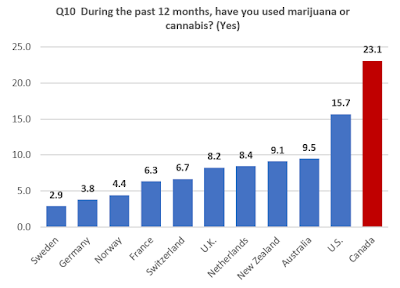This week the Canadian Institutes of Health Information released the results of a health survey conducted simultaneously in Canada and 10 other developed countries. Between March and June last year (in the first wave of COVID-19), surveyors asked more than 5,000 adult Canadians about certain health behaviours and about their access to health-care services. The same questions were put to adults in 7 European countries (France, Germany, Netherlands, Norway, Sweden, Switzerland and the United Kingdom), and also in the United States, Australia and New Zealand.
The Commonwealth Fund's 2020 survey of the General Population is sponsored by the U.S.-based health charity the Commonwealth Fund, and partnered in Canada by CIHI and provincial agencies.
The survey asked about commonly-used drugs use. These included questions on the use of tobacco and e-cigarettes, heavy drinking, and cannabis use. This blog presents data from the survey which can be downloaded from CIHI.
Tobacco use is lower in Canada
This survey found that one in five (21%) Canadians identified as a smoker, 15% on a daily basis and 6% on an occasional basis. On this score Canada did better than in all but 3 countries - the USA, Australia and New Zealand.
This is noticeably higher than the estimates produced by other government surveys (15% in 2019 for the Canadian Community Health Survey and 12% in 2019 by the Canadian Tobacco and Nicotine Survey.) In addition to the inherent fluctuations of survey estimates, the design of the survey may also have produced higher results: it did not include people as young as 12 and 15 as the other surveys did, it asked about all tobacco use, and not just cigarette smoking, and it the nature of the study may have encouraged different types of people to participate. The response rate of this study was 19%, compared with 44% for the CTNS (8,500 respondents).
By asking about all tobacco use, the surveyors avoided one of the challenges of comparing cigarette-smoking countries (like Canada and Australia) with countries where oral tobacco is more common (the U.S.A, Norway and Sweden).
Vaping is higher in Canada
Canada is among a small set of countries which have higher vaping rates - outflanked only by the USA, France, the U.K. and New Zealand.
The view of Canada as a heavy-vaping country was reinforced by a presentation made by Philip Morris International to investors earlier this week. In it, the company included Canada among the 8 countries which made up almost two-thirds of the vaping market outside the USA and China. Others in this group included France, Germany and the U.K.
For this behaviour, this survey produced very similar results to the Canadian Tobacco and Nicotine Survey, including for the age-breakdown that was provided for vaping behaviour. Both surveys found that vaping was higher for those under 35 years of age (11%), compared with 2%-3% for those over 35 years old.
Canadian clinicians counsel one-half of smokers to quit
Canada is middle-of-the-pack when it comes to providing smokers with advice or assistance to quit smoking.
Canada is 'average' when it comes to heavy drinking.Canadians may think of Australians and the French as heavier drinkers, but when it comes to drinking in excess of lower-risk guidelines, Canadians are in the same ball-park.
Canadians are much more likely to use (or to admit using) cannabis
This survey found that one-quarter of Canadian adults had used cannabis in the past year, three to four times the rate in Europe and double the rate in Australasia. The findings are consistent with other government surveys of cannabis use.





